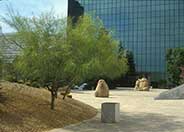
Common name:Mexican Palo Verde, Jerusalem Thorn
Botanical name:Parkinsonia aculeata
Prickly stems. Very fast growing with sparse foliage & very long narrow leaves. Yellow flowers with orange red throats spring for month+. Very messy, thorny, weedy & shortlived. Usually found on limestone soils in areas with moisture but is strongly drought tolerant. Withstands saline conditions. Can be cold or drought deciduous. Half hardy to Dallas. Light airy tree. Green bark.

Common name:Pearson's Aloe
Botanical name:Aloe 'Hellskloof Bells'
Upright growing shrubby plant to about 2 feet tall and wide with short lanceolate gray-green leaves that blush maroon in full sun and produce a capitate head of pendant tubular flowers that are pink in bud and open to a soft pastel orange. Plant in full sun to light shade (best foliage color with brightest light) in a well-drained soil and irrigate only occasionally to infrequently. We have had plants not damaged at 25° F and have seen reports that it is hardy to at least 20° F. This unique plant will make a nice addition in the garden planted in the ground or used as a potted specimen. It is a hybrid created by Brian Kemble of the Ruth Bancroft Garden in 1991 that was the result of crossing the beautiful but slow growing, and difficult to cultivate, Aloe pearsonii with the faster growing and easy to grow Aloe mitriformis, which at the time of the cross was called Aloe distans (or A. perfoliata var. distans). Aloe pearsonii hails from an area called Helskloof in the mountainous Richtersveld of the Northern Cape province of South Africa where it forms large colonies with upright columnar branches of stubby red-blushed leaves and the pollen parent Aloe mitriformis is a plant that grows along the coast in the Western Cape province of South Africa. The cross made of these two geographically separated species resulted in a several similar hybrid plants that were distributed and this one was later named by John Trager at the Huntington Botanic Garden. It does best in full sun.
Designer: Ruth Bancroft Garden
Photographer: Vicki Anderson
Maintain a two to four inch layer of mulch on the soil surface to reduce weeds, infiltrate rain water, and reduce compaction.
Remove irrigation water and fertilizer from areas where you don't want weeds to grow.